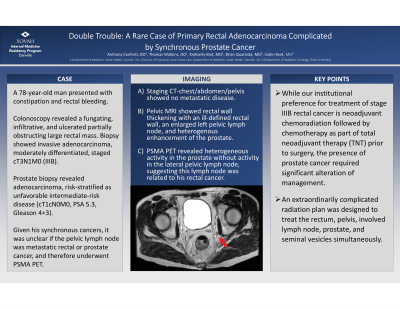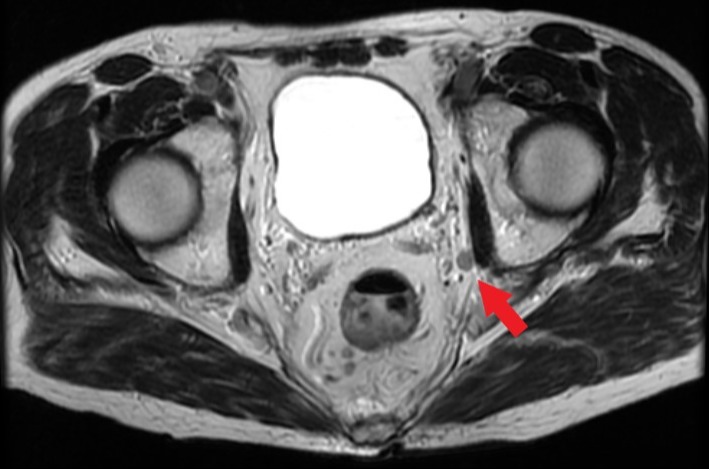Tuesday Poster Session
Category: Colon
P3716 - Double Trouble: A Rare Case of Primary Rectal Adenocarcinoma Complicated by Synchronous Prostate Cancer
Tuesday, October 29, 2024
10:30 AM - 4:00 PM ET
Location: Exhibit Hall E

Has Audio

Thomas P. Watkins, DO
Sovah Health
Danville, VA
Presenting Author(s)
Anthony Conforti, DO1, Thomas P. Watkins, DO1, Kimberly Bird, MD1, Brian Quaranta, MD2, Collin Kent, MD2
1Sovah Health, Danville, VA; 2Duke University Health System, Durham, NC
Introduction: This case displays a rare occurrence of two synchronous primary malignancies and sheds light on the complex management with chemotherapy, androgen deprivation therapy, and an unusually intricate radiotherapy (RT) plan.
Case Description/Methods: A 78-year-old man initially presented with constipation and rectal bleeding. Colonoscopy revealed a fungating, infiltrative, and ulcerated partially obstructing large rectal mass. Biopsy showed invasive adenocarcinoma, moderately differentiated. Staging CT showed no evidence of metastatic disease. Pelvic MRI showed rectal wall thickening, an enlarged left pelvic lymph node, and heterogenous enhancement of the prostate. His PSA was previously elevated, so urology performed a prostate biopsy, which revealed adenocarcinoma, Gleason 4+3. Given his synchronous cancers, it was unclear if the pelvic lymph node was metastatic rectal or prostate cancer, and therefore underwent PSMA PET, which revealed heterogeneous activity in the prostate without activity in the enlarged lateral pelvic lymph node, suggesting this lymph node was related to his rectal cancer. His rectal cancer was staged cT3N1M0 (IIIB), and prostate cancer was risk-stratified as unfavorable intermediate-risk disease (cT1cN0M0, PSA 5.3, Gleason 4+3).
Discussion: While our institutional preference for treatment of stage IIIB rectal cancer is neoadjuvant chemoradiation followed by chemotherapy as part of total neoadjuvant therapy (TNT) prior to surgery, the presence of prostate cancer required significant alteration of management. Instead, TNT began with chemotherapy to expedite treatment of his rectal cancer while awaiting workup for prostate cancer, as initiating RT for rectal cancer would have significantly complicated future treatment of his prostate. After prostate cancer was diagnosed, the patient initiated short term androgen deprivation therapy (ST-ADT) while completing neoadjuvant chemotherapy. Following completion, an extraordinarily complicated radiation plan was designed to treat the rectum, pelvis, involved lymph node, prostate, and seminal vesicles simultaneously. The pelvis was treated to a dose of 45 Gy in 25 fractions, the rectum to a total dose of 50.4 Gy in 28 fractions, and the prostate and seminal vesicles received simultaneous integrated boosts (SIB) to doses of 70 Gy and 58.8 Gy, respectively; given that the planned surgery would not include a lateral pelvic lymph node dissection, the enlarged node received an SIB to a definitive dose of 64.4 Gy in 28 fractions.

Disclosures:
Anthony Conforti, DO1, Thomas P. Watkins, DO1, Kimberly Bird, MD1, Brian Quaranta, MD2, Collin Kent, MD2. P3716 - Double Trouble: A Rare Case of Primary Rectal Adenocarcinoma Complicated by Synchronous Prostate Cancer, ACG 2024 Annual Scientific Meeting Abstracts. Philadelphia, PA: American College of Gastroenterology.
1Sovah Health, Danville, VA; 2Duke University Health System, Durham, NC
Introduction: This case displays a rare occurrence of two synchronous primary malignancies and sheds light on the complex management with chemotherapy, androgen deprivation therapy, and an unusually intricate radiotherapy (RT) plan.
Case Description/Methods: A 78-year-old man initially presented with constipation and rectal bleeding. Colonoscopy revealed a fungating, infiltrative, and ulcerated partially obstructing large rectal mass. Biopsy showed invasive adenocarcinoma, moderately differentiated. Staging CT showed no evidence of metastatic disease. Pelvic MRI showed rectal wall thickening, an enlarged left pelvic lymph node, and heterogenous enhancement of the prostate. His PSA was previously elevated, so urology performed a prostate biopsy, which revealed adenocarcinoma, Gleason 4+3. Given his synchronous cancers, it was unclear if the pelvic lymph node was metastatic rectal or prostate cancer, and therefore underwent PSMA PET, which revealed heterogeneous activity in the prostate without activity in the enlarged lateral pelvic lymph node, suggesting this lymph node was related to his rectal cancer. His rectal cancer was staged cT3N1M0 (IIIB), and prostate cancer was risk-stratified as unfavorable intermediate-risk disease (cT1cN0M0, PSA 5.3, Gleason 4+3).
Discussion: While our institutional preference for treatment of stage IIIB rectal cancer is neoadjuvant chemoradiation followed by chemotherapy as part of total neoadjuvant therapy (TNT) prior to surgery, the presence of prostate cancer required significant alteration of management. Instead, TNT began with chemotherapy to expedite treatment of his rectal cancer while awaiting workup for prostate cancer, as initiating RT for rectal cancer would have significantly complicated future treatment of his prostate. After prostate cancer was diagnosed, the patient initiated short term androgen deprivation therapy (ST-ADT) while completing neoadjuvant chemotherapy. Following completion, an extraordinarily complicated radiation plan was designed to treat the rectum, pelvis, involved lymph node, prostate, and seminal vesicles simultaneously. The pelvis was treated to a dose of 45 Gy in 25 fractions, the rectum to a total dose of 50.4 Gy in 28 fractions, and the prostate and seminal vesicles received simultaneous integrated boosts (SIB) to doses of 70 Gy and 58.8 Gy, respectively; given that the planned surgery would not include a lateral pelvic lymph node dissection, the enlarged node received an SIB to a definitive dose of 64.4 Gy in 28 fractions.

Figure: Prominent pelvic lymph node adjacent to the left posterior acetabulum, measuring 11 mm in maximal diameter.
Disclosures:
Anthony Conforti indicated no relevant financial relationships.
Thomas Watkins indicated no relevant financial relationships.
Kimberly Bird indicated no relevant financial relationships.
Brian Quaranta indicated no relevant financial relationships.
Collin Kent indicated no relevant financial relationships.
Anthony Conforti, DO1, Thomas P. Watkins, DO1, Kimberly Bird, MD1, Brian Quaranta, MD2, Collin Kent, MD2. P3716 - Double Trouble: A Rare Case of Primary Rectal Adenocarcinoma Complicated by Synchronous Prostate Cancer, ACG 2024 Annual Scientific Meeting Abstracts. Philadelphia, PA: American College of Gastroenterology.
